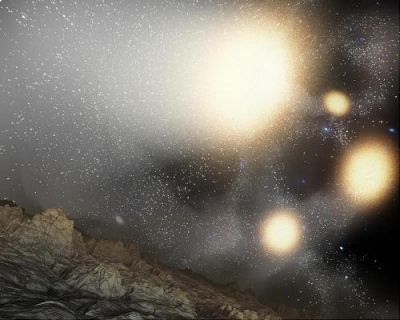This is a particularly violent event in which billions of stars are blown out of place. Probably the largest collision observed to date
This is how the sky looks from one of the planets orbiting one of the suns in the galaxy among the four colliding galaxies. Artist illustration - NASA
Galaxies are not born, they evolve, they are built during a series of mergers lasting billions of years. In most cases, the process is slow and steady, with galaxies tearing apart the small satellite galaxies that surround them and accumulating mass. However, in the case of one cosmic collision observed by NASA's Spitzer Space Telescope, four extremely massive galaxies merged together simultaneously in a chain accident. The process caused billions of stars from these four galaxies to fly into intergalactic space.
The merging quaternion was discovered unexpectedly during a Spitzer Space Telescope survey of a distant galaxy cluster known as CL0958+4702, and which is 5 billion light years away from us. The telescope, which photographs at infrared frequencies, first observed a large fan-like plume of light coming from a cluster of four elliptical galaxies. Three of these galaxies were the size of the Milky Way and the fourth was 3 times larger.
These colliding galaxies finally formed one galaxy whose mass is 10 times that of the Milky Way - it may be one of the largest known galaxies in the universe. We will have a similar feeling in 5 billion years when the Milky Way merges with Andromeda.
"Most of the galaxy mergers we know are like small cars that have crashed together," says Kenneth Rines of the Harvard-Smithsonian Institute for Astrophysics in Cambridge, Massachusetts. "In this case, it is four sand trucks crashing into each other, and the sand is scattered everywhere." Galaxy mergers are a common phenomenon in the universe. Gravity causes nearby galaxies to swirl with each other until eventually, over billions of years, they merge. Usually the stars of the eaten galaxies find a place among the stars of the receiving galaxy, like grains of sand. And they have a lot of space. It is not certain that this will happen even in the case of mergers of large galaxies such as the Milky Way and Andromeda. Galaxy mergers are one of the major events that trigger the birth of new stars, when they change the balance of dust in galaxies and create new star hotbeds. However, Spitzer did not discover in this case any gas and dust, not even a single region of new star formation, only old stars.


5 תגובות
Please expand on the type of infrared photography
I asked my father.
Is it likely that after such a large collision (the largest observed to date) no new stars will be formed??? Doesn't this suggest that it is a fundamental mistake in reading the data?
Is it possible that it takes time to receive the radiation from the new stars and only in thousands of years or more they will reach our galaxy?
I would love to receive a brief explanation on how to know that there was a collision and how to determine whether there are new stars.
the difference :
and despite the difference; Even with the signage on the roads on Earth, there are no shortage of collisions.
Thanks. Done, just a matter of a stubborn keyboard.
Need to go through proofreading...
From the article: to whirl this rage until they were defeated, for